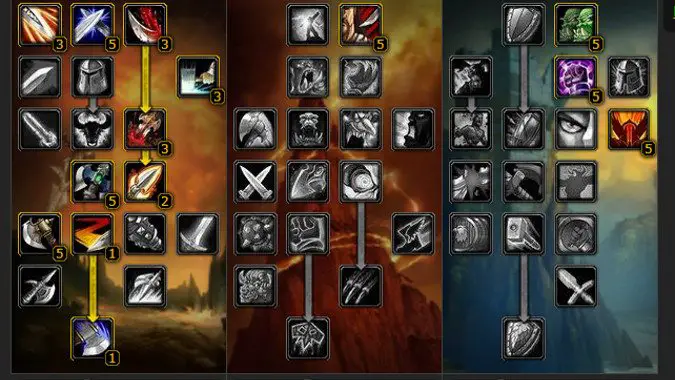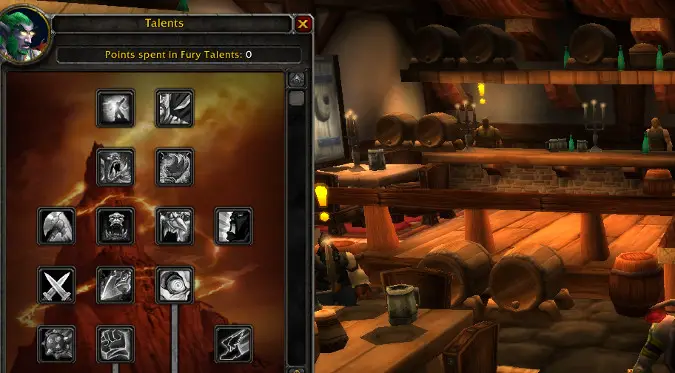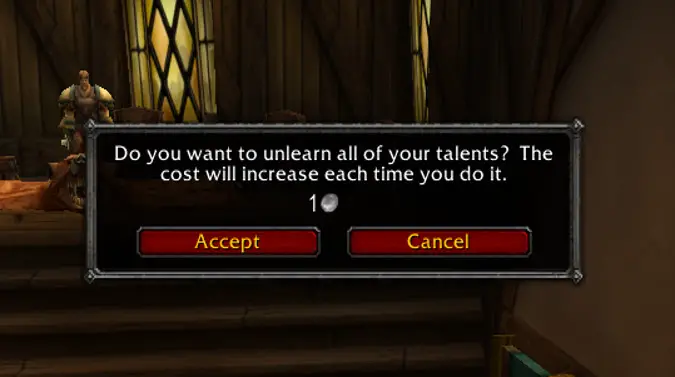What are talents and talent trees in WoW Classic?

If you’ve only been playing World of Warcraft for the past few years, you might well be pretty used to the way the current talent system works, where you have three talents per tier and can choose one of the three, and gain a new talent tier every so often (in most cases, every 15 levels or so until you hit level 90, and then a last tier at level 100). While WoW Classic doesn’t go to level 100 or above, it actually has more talent points to consider and a different system for spending them.
In WoW Classic, you’ll be gaining talent points on a per-level basis — you get your first talent point at level 10 and keep gaining them until level 60, meaning that you end up with 51 talent points in total. To give you an idea, here’s a post I wrote a while back full of various Warrior endgame specs from the old days, useful here as an example of the ways you could spec your character back then. You’ll note that your actual spec wasn’t a direct choice back then like it is today — you didn’t spec as a Ret Paladin at level 10, you simply started spending talent points and, if you had spent the majority of your points in Retribution by around level 50 or so, you were considered a Ret Paladin. This was considered your Talent Specialization.

Climbing the trees
Talents were broken up in Classic in a way that should be somewhat familiar to anyone who is familiar with current in-game specs. Each class had three trees. Each tree was based around a theme or concept, such as a Priest getting Holy, Shadow and Discipline as their talent trees, or a Warlock’s Affliction, Demonology and Destruction. These individual trees all had a 31 point talent that served as the crown of the tree — some actually had more than one, giving you an option as to which talent you picked, but most didn’t. In order to get to that 31 point talent, you had to spend points in the tree to unlock higher talent tiers. You can see this illustrated here as I spent various points throughout the Affliction tree to get to Dark Pact. Please don’t tell me that I did a terrible job, I’m well aware I know nothing about playing a Warlock.
Unlike today, you’ll note that instead of a level dependency, talents require investment in the tree itself in order to proceed — you can’t get your 31 point talent without spending 30 points in a tree. All trees had talents at the top that you could take immediately as soon as you hit level 10, and then as you spent more and more points in the tree you would unlock further talents that required you to have spent five, ten, fifteen, twenty and twenty-five points to proceed. In addition, some talents were dependent on other talents — you couldn’t take Shadow Master if you hadn’t taken Siphon Life, for example. Since the way you spent your talent points determined your spec, you could blaze through and get your 31 point talent at level 40 if you made sure to spend all your talents in your tree of choice, or you could dabble a bit in other specs for synergy. Almost no talent build at the time recommended spending too much more than 31 points in a tree — you were encouraged to spend points in another tree to unlock synergy between the talents, such as this 31 Arms/20 Fury build that was extremely common.

Insert Ackbar.gif here
Things to be wary of with this talent system is that most talents require between three and five points of investment to get the full benefit of the talent, and that some talents were by design “traps.” They existed to get you to spend points in a less than optimal way, and it was acknowledged by the game developers at the time that almost all players of a particular spec would hit upon one of a couple possible builds that worked well and anyone not using those builds would be at a disadvantage.
While many players made the assumption that the 51 talent point, three tree system allowed for flexibility and variation, in fact it ended up with most players falling into a cookie cutter build that was basically the same as every other player of that spec. In fact, I spent most of my time back in 2007 to 2012 coming up with posts advising people on which spec to play and explaining why — as an example — Improved Charge was basically useless once you were in endgame content because you couldn’t charge once you were in combat. So many Warriors went with this build back in the old days, it was rare to see an Arms Warrior who didn’t dip into Prot for offtank roles.

You can respec, but it will cost you
You may be thinking what happens if I make a mistake and buy a bad talent and that’s a good question. Luckily for you, WoW Classic isn’t going with the original patch 1.0 version of the talent system, because the answer would have been you live with it. Respeccing wasn’t immediately available in the original game, but it was in place by patch 1.12.
You’ll be able to spend gold to respec your talents if it turns out you don’t like them or want to try a new role. But it’ll cost you — while it starts at an affordable 1 silver, each respec increases the cost up to a 50g cap if you’ve respecced frequently. Considering that your first mount cost around 80g, you can imagine that respeccing wasn’t something people wanted to do very often, which is why it was rare to find a pure Protection Warrior who wasn’t a main tank in their guild, or why Holy Paladins still strapped on 2h weapons and DPS gear and went out into the world trying to solo things instead of spending 45g to respec to Retribution. You should probably expect to respec at least once after you hit 60, but try to avoid doing it afterwards as it will really drain your pockets of gold.
That covers the basics of the talent system you’ll find waiting for you in WoW Classic. Remember to pay attention to the talents you most enjoy playing with and it’s usually best to spend most of your points in the tree you intend to play in as fast as possible — getting the 31 point talent at level 40 was usually a solid addition to your class. I’ll be out there Mortal Striking things as well, I’m sure.
Please consider supporting our Patreon!
Join the Discussion
Blizzard Watch is a safe space for all readers. By leaving comments on this site you agree to follow our commenting and community guidelines.
 @MatthewWRossi
@MatthewWRossi




